Even with the best intentions, homegrown tomato plants can produce disappointingly small tomatoes. For a home gardener, this can be extremely frustrating and a problem I am familiar with. So if you have small tomatoes growing on your plants, you’ll want to find out why and how to fix the problem. Read on to find out.
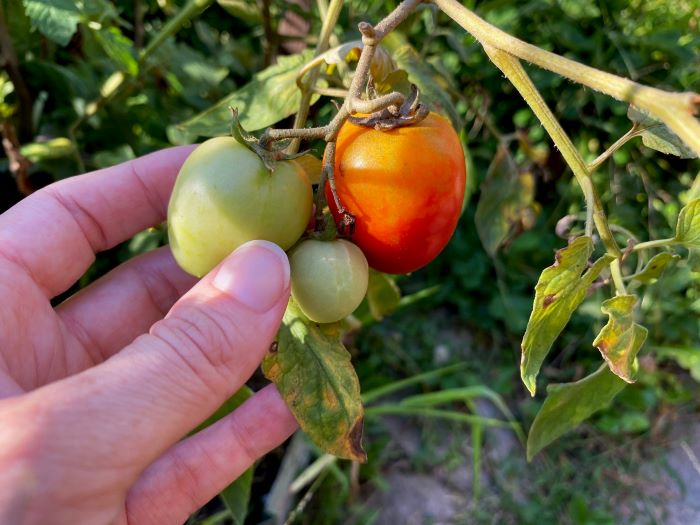
Table of Contents
Why Are My Tomatoes So Small?
The most common reasons your tomato plant is producing small fruit are water stress, over-fertilization, poor soil conditions, lack of sunlight, high temperatures, lack of pollination, and issues with when and how they were planted.
Let’s look at each cause of small tomatoes in detail and exactly how to fix it.
1. Water Stress
One of the most likely reasons your tomato plants are producing small fruits is water stress. Tomatoes need a lot of water to thrive, but knowing how much and when to water tomatoes can prove a bit tricky.
When a tomato plant experiences water stress, it struggles to take up enough water from the soil to meet its needs. Water stress can severely impact your tomato plant by stunting its growth and can impact the development of the fruit itself.
Without enough water, the tomato fruit may not receive the necessary nutrients and minerals for proper growth and development, resulting in smaller fruit. The way to fix water stress is to maintain a regular watering schedule.
When to Water Your Tomatoes
Tomato plants need regular watering, with the schedule depending on the size and age of the plant. Younger tomato plants need more watering than older plants. Also, tomato plants that already bear fruit should not be overwatered, as the skin may crack.
When adjusting your watering schedule to the age and size of the plant, you also need to consider temperature and weather conditions. In particularly hot weather, the soil around your tomato plants dries out faster, so you need to water them more often.
Check your tomato plants daily and water them slowly and thoroughly when the soil is dry.
I also apply a layer of organic mulch around my tomato plants to help keep the soil moist and it’s definitely a tip I recommend to help keep the soil healthy and retain moisture.
2. Over-Fertilization
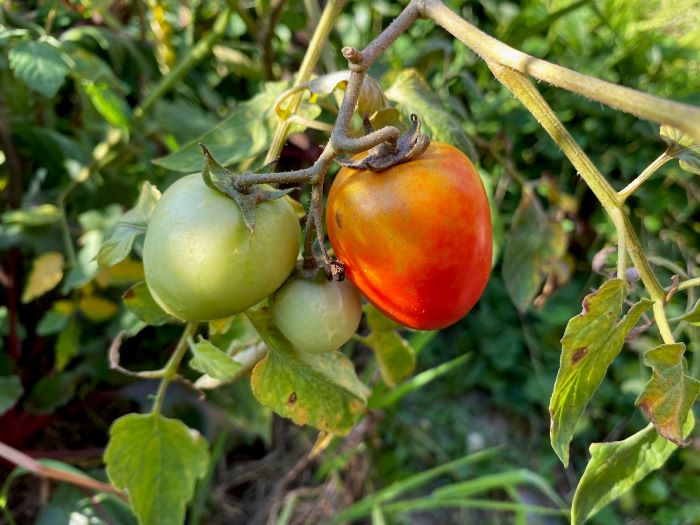
Over-fertilization of tomato plants is another leading cause of small fruit development. If your tomato plant seems to be thriving and growing a large amount of foliage but is producing small tomato fruit, it may have been over-fertilized.
It is super easy to over-fertilize your tomatoes because they are hungry plants. This reputation can cause some people (myself included) to overfeed their tomato plants.
Fertilizing more than once every two weeks with a nitrogen-rich fertilizer will cause your tomato plants to produce small fruit. Rather than producing big and juicy fruit, excess nitrogen forces plants to produce green foliage.
Over-Fertilization can be corrected firstly by not applying any more fertilizer. Secondly, you can help your over-fertilized tomato plant by removing any excess fertilizer by hand. Once you have done this, you can soak the soil to flush away the remaining fertilizer.
There is a slight concern when doing this that you could waterlog your tomato plants, so make sure you do this in the early morning. I really like this organic fertilizer for my tomato plants.
3. Poor Soil Conditions
Although tomato plants are pretty tolerant of most soils, certain soil conditions can negatively affect the fruiting of your tomato plant.
A nutrient-rich, well-draining, loamy, or sandy soil is ideal for tomatoes. As mentioned earlier, tomatoes thrive in most soils, except for soils with high clay content.
The soil pH balance is also important when it comes to producing large tomato fruits. Tomatoes prefer slightly acidic soil. The pH level of your soil should be between 6.2 and 6.8.
Poor soil conditions can affect your tomato plant’s ability to absorb much-needed nutrients and minerals from the soil, resulting in small fruit production. You can check the condition of your soil with a soil monitor like this one.
You can add good organic compost to your tomato plants or well-aged animal manure to fix poor soil conditions. These will improve soil fertility and structure. If your soil pH level is off, you can amend it with either lime (to raise pH) or sulfur (to lower pH).
4. Lack of Sunlight
Another reason why your tomato plants bear small fruits is related to the sun, or rather, a lack thereof. Tomato plants need between 6 and 8 hours of sunlight per day to produce enough energy for large fruits.
If your tomato plant does not get the correct amount of sunlight per day, the fruits it produces will be small. To ensure that your tomato plants have the best chance of producing large enough fruit, plant them in a sunny location.
Another way you can help your tomato plants get as much sun as they need is by pruning them. By regularly pruning your tomato plants, you can prevent excess foliage from blocking the sun and stop your plants from using energy unnecessarily.
5. High Temperatures
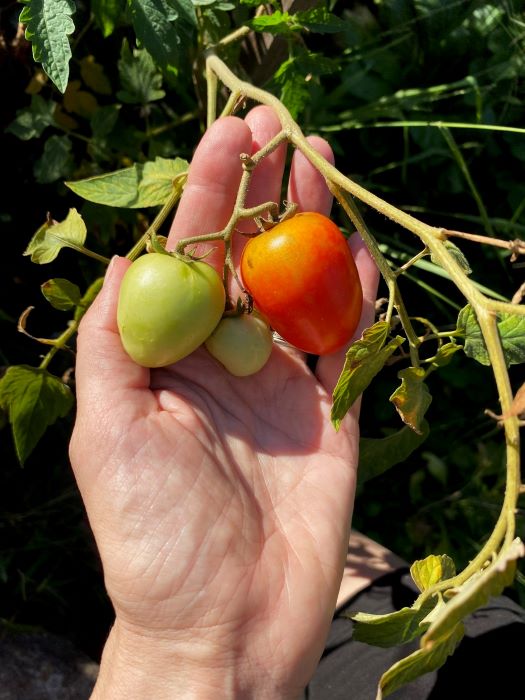
High temperatures can stress your tomato plant and cause it to produce small fruit. Tomato plants like warmer weather, thriving in temperatures ranging between 70-85 °F (21-29 °C), but anything over that and your tomato plant can become stressed.
Heat stress can cause your tomato plant to struggle to take up enough water from the soil to meet its needs. When the plant’s needs aren’t met, it will produce smaller tomato fruit.
To combat heat stress, you can provide shade for your tomato plants during the hottest part of the day. This can be done by covering the plants with a shade cloth or a temporary outdoor umbrella. The other thing to do is to make sure you are watering your tomato plant enough. During heat waves, this can mean watering your tomato plants twice a day if the soil is dry.
6. Poor Pollination
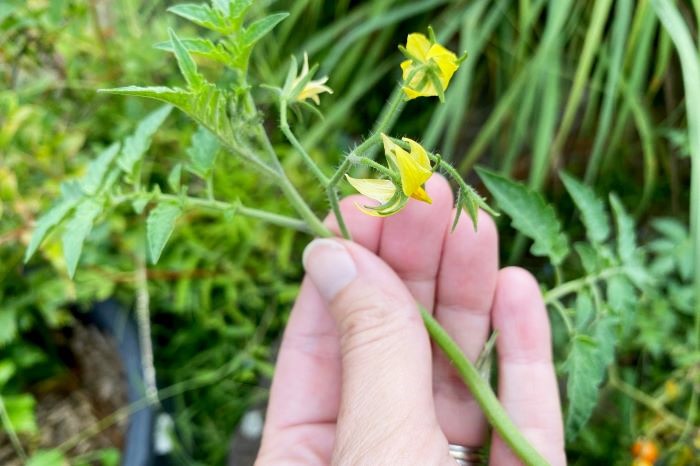
Pollination is an essential process in the development of tomato fruit. If there was a problem during the pollination process, your tomato plant might produce small tomatoes.
Tomato plants are self-pollinating, meaning they do not need pollen to transfer from one flower to another. Instead, the pistil (the female part) is pollinated by the stamen (the male part) which occurs through the natural movement of wind and is assisted by insects visiting and moving pollen around the flower.
However, several factors can affect pollination, including high humidity and a lack of natural pollinators.
High humidity can cause issues with the release of pollen from the flowers resulting in a lack of pollination. Bees are natural pollinators, so if they are noticeably absent from your garden, it can affect the successful pollination of your tomato plants.
To fix this problem, you can gently shake your tomato plants to help release the pollen.
And to help attract natural pollinators into your garden, try planting more flowers. I love nasturtiums especially because you can eat nasturtium flowers, leaves and seeds and this African Blue Basil produces gorgeous flowers that bees can’t resist!
7. When and How Tomatoes Were Planted
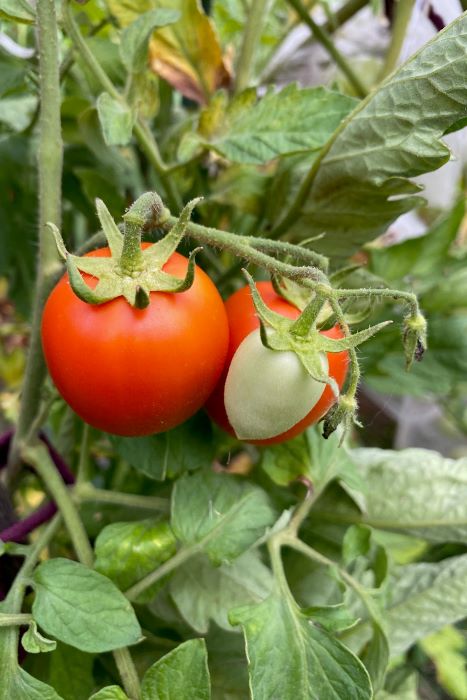
The final reason why your tomato plant may be producing small tomatoes is connected to when they were planted. How and when you plant your tomatoes can affect the production of fruit.
When to Plant Tomatoes
Firstly, when you plant your tomatoes has a huge impact. Planting tomatoes too early or too late in the season can lead to less-than-ideal growing conditions.
Tomatoes should be planted when the soil has warmed up, and there is no danger of frost. In most regions, this means planting tomatoes in spring or when temperatures are consistently above 50 °F (10 °C) at night.
If tomatoes are planted too early in the season when the soil is still cold, the plant’s growth will be slow, and it may struggle to produce large, healthy tomatoes. Cold soil can also lead to poor nutrient uptake, which can cause the tomato plant to produce small tomatoes.
To avoid planting your tomato plants at the wrong time, you must know your region’s frost dates.
If you planted your tomatoes when the soil was still cold, adding a phosphorus-rich fertilizer will help to combat the lack of nutrient uptake.
How to Plant Tomatoes
How you plant your tomatoes is just as important as when because planting tomatoes too shallow or too close together can cause small fruits. Tomatoes should be planted deep into the soil because otherwise, their root system will be restricted, in turn restricting plant growth and fruit production.
If you are planting tomato seeds, sow them between ¼ and ⅛ of an inch deep.
If you are transplanting tomato seedlings from pots to the garden, you can afford to plant your tomato seedlings quite deeply. You can actually bury 2/3 of the tomato plant in the ground, though be sure that the leaves are off the ground. Planting tomatoes deeply will help them to grow strong roots.
And depending on your variety, space tomatoes at least 2 to 3 feet ( 60-90cm) apart. Overcrowding can create competition for resources such as sunlight, water, and nutrients, leading to the development of smaller fruits.
If you have planted your tomato plants too close together, the first thing you can do is prune your plants. Remove any excess foliage to try to limit the fight for sunlight while improving air circulation.
Secondly, you can remove some of your tomato plants. Removing plants will improve your tomato plants’ chances of producing larger fruits.
Remove the plants carefully, making sure you do not damage their root system and transplant them in a more suitable spot. I should warn you that tomato plants do not take kindly to being transplanted. You may lose the plant in the process but in an overcrowded situation, it’s still worth trying. Many of my tomato transplants have been successful especially when they are still small.
Further Reading:
